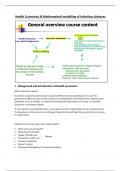Class notes
Class notes and summary of health economics and mathematical models of infectious diseases FBDBMW2108 (16/20)
- Course
- Institution
Summary of health economics and mathematical models of infectious diseases. It includes class notes of every slide, results for exercises and some summaries.
[Show more]



